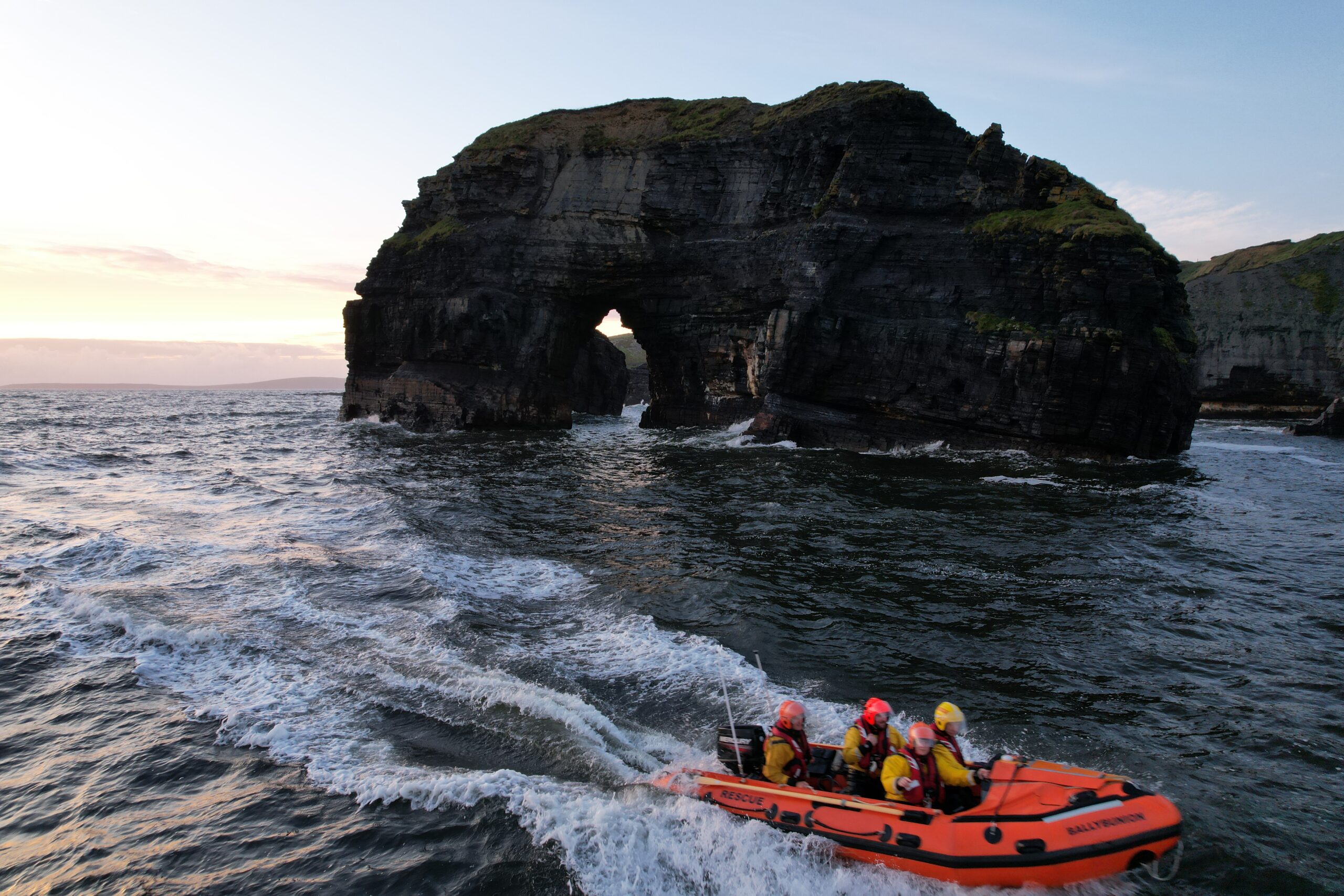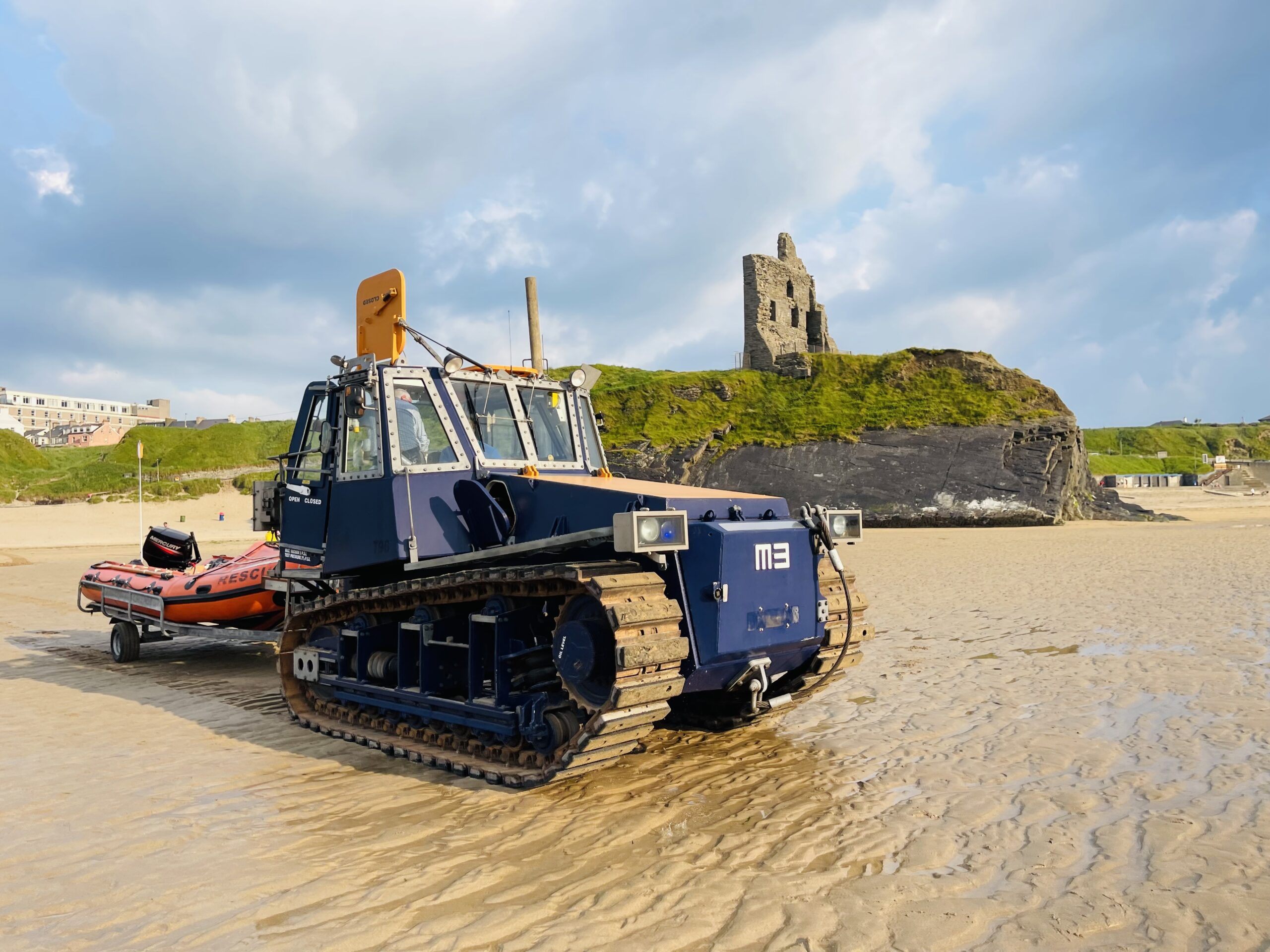Our Equipment
To keep you safe and protective here is what we use to do it.
IB1 D Class

The IB1 D-Class inflatable boat is the work horse of Ballybunion Rescue. The boat is powered by a Mariner immersion proof 2 stroke 50 hp engine and is built by the RNLI to rescue spec in Cowes, UK. The boat cost in the region of €30,000 in 2023. This fast, light inflatable can be used in many locations but is especially suited to surf, shallow water and confined locations……all of which combined makes Ballybunion one of the most dangerous of rescue locations. Due to the conditions, the natural choice for us is the D Class.
The original D Class, the EA-16, was originally introduced by the RNLI in 1963 and was our primary response boat from the early 90s through to 2023. We have evolved through three EA-16 boats over the years, one of which was purchased new in 2006. The RNLI has spend an incredible amount of money, time and effort in the research and development of the platform and the D Class has continually evolved to the current IB1. Naturally, due to their experience and development, we have continued to model our service on RNLI practices.
Additional Information
Length – 5 meters
Beam – 2 meters
Draught – 0.52 meters
Displacement – 500kgs,
Fuel Capacity – 68 litres (twin 34 litre tanks)
Max Speed – 25 knots
Range/Endurance – 3 hours at maximum speed
Construction – Hypalon coated polyester
Crew – 3/4
Survivor Capacity – 5
Marine VHF radio
Onboard global positioning system (GPS) plotter
Automated Identification System (AIS)
Atlantic 75

The Atlantic 75 (B-Class) is a Rigid Inflatable Boat built by the RNLI in Cowes, UK. The boat, which unlike other rescue boats, is built to rescue specifications and is solely built for rescue only and not pleasure use. The RIB was bought new at a cost of €170,000 and was delivered in April 2010. BSCR’s Atlantic 75 is named the “Tommy C” after Tommy and Clara Duggan. The original Atlantic 21 was named the “Clara T” after the Duggan family of Ballybunion made the single biggest donation in the history of the service to go towards the A21. The committee of 2010 decided to was only right to continue to honour the family. The new A75 was officially named by Derek Nagle, grandson of Tommy and Clara.
The Atlantic 75 was first introduced in 1993 to replace the Atlantic 21. The A75 has many updates from the A21, the biggest one being the addition of a ballast tank that can be filled or emptied while the RIB is under way to provide better handling in rough seas. It offers the capability of servicing the North Kerry and Clare coastline along with the greater Shannon estuary for vessels in distress. Providing a fast response, it also increases our ability to tow larger vessels in distress.
The Atlantic 75 launches by driving off a trailer into the surf. Once the exercise or tasking is completed, it recovers into the same trailer by way of a net that “catches” the bow of the boat. Once in the station, the A75 is then lifted from the trailer, turned 180 degrees and re-positioned on the trailer for the next launch.
Additional Information
Length – 7.38 meters
Beam – 2.65 meters
Draught – 0.41 meters
Displacement – 1600kgs,
Fuel Capacity – 182 litres (twin 91 litre tanks)
Max Speed – 35 knots with twin 90hp Yamaha two stroke engines
Range/Endurance – 3 hours at maximum speed
Construction – Polyester glass reinforced fibre hull with marine plywood stiffening. Hypalon coated nylon tubes.
Crew – 3
Survivor Capacity – 20
Marine VHF radio
Onboard global positioning system (GPS) plotter
Automated Identification System (AIS)
Talus MB-H amphibious tractor
Purpose designed and built by Clayton Engineering Limited in Wales under contract for the RNLI, the Talus MB-H is a continuous track launch tractor that was designed for launching both offshore and inshore rescue boats from beach and shore settings.
The Talus, purchased in 2023, is a significant upgrade for the service providing a reliable vehicle to launch both rescue boat platforms. With much improved vision for the driver, the tractor can be operated from the front and the back with the driver’s seat swivelling 180 degrees. The tractor is designed to be immersion proof in the event that it fails while launching. It can be made secure and watertight and can safely spend 24hours submerged in up to 9 metres of water. This level of immersion proofing allows the tractor to then be recovered in low tide without any damage to the vehicle or indeed, the ecosystem of Ballybunion. The Talus is also fitted with a large drum winch to the rear.

Additional Information
length – 5.5 meters
Width – 2.4 meters
Height – 3 meters
Engine Caterpillar – 3208 V8 Diesel
Gross Power – 210hp (160 kW)
Propulsion – Rubber topped steel tracks
Speed – 12 km/h
Rescue 4X4
Our current rescue 4×4 is a 2003 Mitsubishi L200. The 4×4 is used for towing boats to inland taskings, for search onshore and inland, moving equipment, transporting members and for PR events. It is a work horse that is unfortunately aging and now in need of replacement.

Boat Crew PPE
Our boat crew and Coxswains are all kitted for the conditions that present the North Kerry coast.
Our seagoing PPE includes the following:
Drysuit – Typhoon WOSS
Thermal Suit – Also known as a woolly bear, this is a full body fleece
Lifejacket – Crewsaver Inshore 380N. Fitted with inherent 90N buoyancy, this lifejacket protects our crew with a further 290N gas inflation if the worst should occur. Designed, tested and developed in collaboration with the RNLI, crewsaver has specifically launched this lifejacket for rescue crews.
Helmet – Gecko. Providing head protection in the challenging environment we operate in, the helmets also have a full-face visor fitted to keep wind and spray out of crews faces while underway or in surf. We have a range of colours in operation currently.
Sea Going Gloves – We currently have both winter and summer gloves which are worn as the situation dictates.
Lifeboat Crew Kit
| Equipment | Euros |
| Drysuit and boots (ILB) | 908 |
| Thermal suit (ILB) | 169 |
| Lifejacket | 665 |
| Helmet | 395 |
| Seagoing gloves | 28 |
| Balaclava | 23 |
| Average training cost per crew member | 1,579 |
| Personal Location Beacon (PLB) | 315 |
